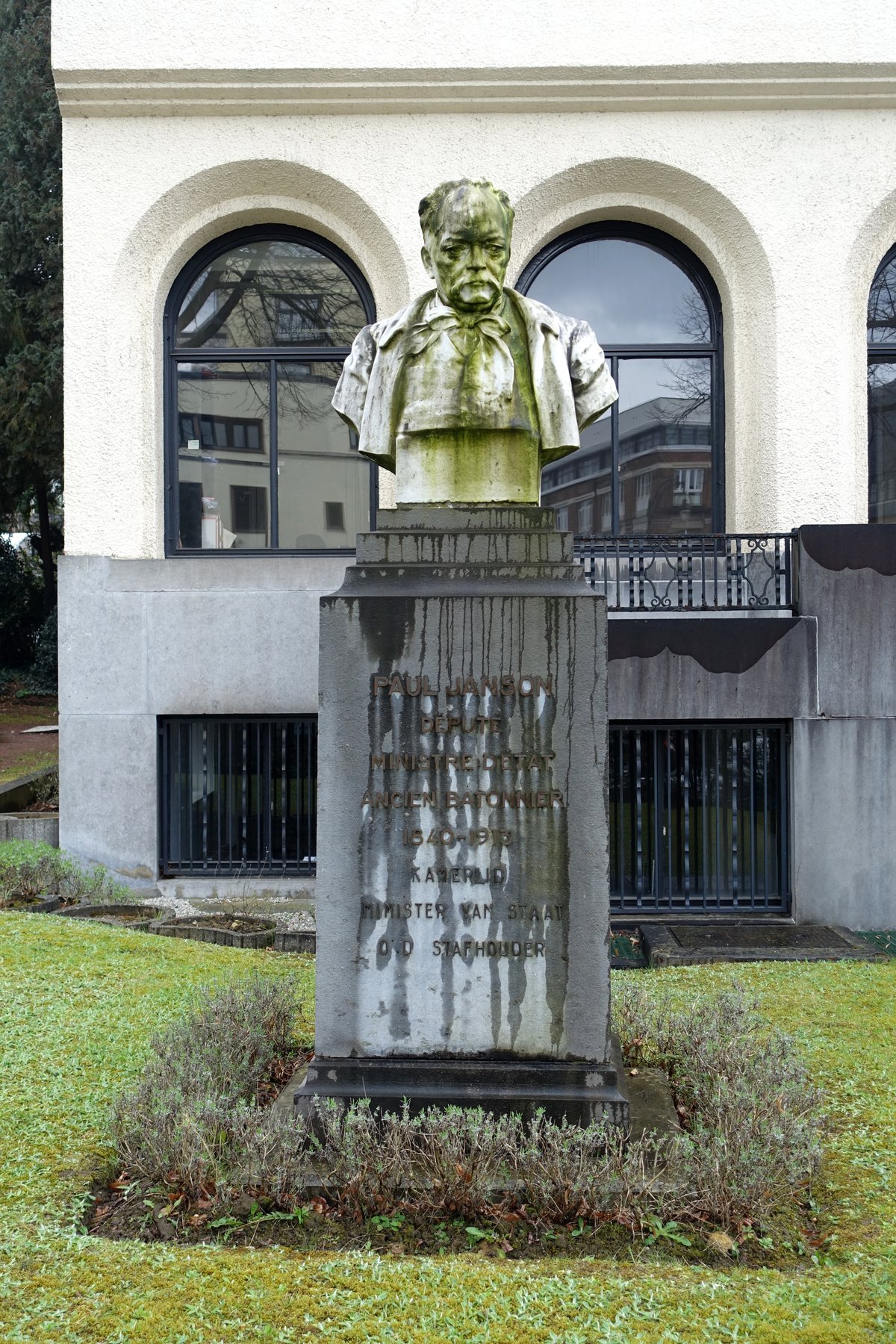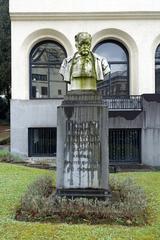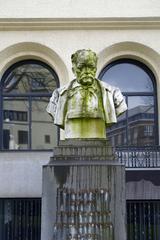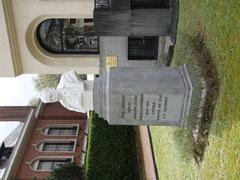
Bust of Paul Janson: Visiting Hours, Tickets, and Travel Guide in Brussels
Date: 14/06/2025
Introduction
The Bust of Paul Janson is a prominent public monument in Brussels, commemorating one of Belgium’s most influential liberal politicians and reform advocates. Known for his tireless work in advancing universal suffrage and social justice, Paul Janson’s legacy is deeply woven into Belgium’s democratic evolution. Situated in the culturally vibrant Saint-Gilles district—an area renowned for its Art Nouveau architecture and cosmopolitan character—the bust invites locals and visitors alike to reflect on Belgium’s political heritage and ongoing commitment to civic progress. This detailed guide provides historical context, practical visiting information, accessibility notes, and cultural insights to help you make the most of your visit to this historic Brussels landmark. For planning and additional resources, consult visit.brussels and Monument Heritage Brussels.
Table of Contents
- Introduction
- Who Was Paul Janson?
- The Bust of Paul Janson: Historical & Artistic Significance
- Location and Setting
- Visiting Information
- What to See Nearby
- Guided Tours and Educational Opportunities
- Tips for a Meaningful Visit
- Frequently Asked Questions (FAQ)
- Conclusion
- References
Who Was Paul Janson?
Paul Janson (1840–1913) was a pioneering Belgian liberal politician who played a critical role in the development of modern democracy in Belgium. Born in Herstal and educated in philosophy and law at the Free University of Brussels, he emerged as a formidable advocate for electoral reform and social justice. Janson was instrumental in the push for universal male suffrage, contributing to landmark reforms after the general strike of 1893. His influence continued through his family: his son Paul-Émile Janson served as Prime Minister, and his daughter Marie Janson became the first female member of the Belgian parliament. The Janson family’s legacy continued with Paul-Henri Spaak, a major figure in European integration (Wikipedia: Paul Janson, Wikipedia: Paul-Émile Janson).
The Bust of Paul Janson: Historical & Artistic Significance
The bust of Paul Janson stands as a public tribute to his enduring contributions to Belgian political life. Cast in bronze and mounted on a stone pedestal, the sculpture is executed in a realistic style that captures Janson’s intellectual presence. Its installation in the Saint-Gilles district—a hub of artistic innovation and political progress—underscores Janson’s significance as a champion of liberal values.
Public monuments like this serve not only as commemorations but as focal points for civic reflection, education, and commemoration, especially on anniversaries of major democratic milestones. The bust’s presence in Brussels’ tapestry of public art highlights the city’s tradition of honoring reformers and fostering dialogue about democracy and social justice (Monument Heritage Brussels: Place Paul Janson, momaa.org).

Alt text: Bust of Paul Janson in Brussels, bronze monument capturing his dignified presence.
Location and Setting
- Address: 73 Rue Defacqz, Saint-Gilles, Brussels (Brussels Remembers)
- District Context: Saint-Gilles is a lively, multicultural neighborhood south of central Brussels, celebrated for its Art Nouveau heritage, vibrant markets, and creative energy. The bust is attached to a building façade, visible from the street and surrounded by classic 19th-century townhouses.
- Nearby Landmarks: The Horta Museum, Hôtel Tassel, Avenue Louise, and Place Stéphanie are all within walking distance, making this site a convenient addition to any cultural itinerary (Mapcarta, Admirable Facades Brussels).
Visiting Information
Hours and Tickets
- Visiting Hours: Open 24/7; the bust is outdoors and accessible at all times.
- Tickets: No entry fee or ticket required.
- Restrictions: As a public monument, visitors are asked to respect the sculpture and the private residence to which it is attached. Climbing or defacing the bust is not permitted.
Accessibility
- The site is at street level and accessible for wheelchair users; sidewalks are generally flat but may feature some cobblestones typical of Brussels.
- The neighborhood is well-lit and considered safe, with regular foot traffic.
Getting There
- By Tram: “Defacqz” stop (lines 92 and 97) is about 2 minutes away on foot.
- By Metro: Louise/Louiza station (lines 2 and 6) is approximately a 10-minute walk.
- By Bus: Several routes serve Avenue Louise and nearby streets.
- Bicycle: The Villo! bike-sharing scheme has stations in the area.
- Parking: Limited on-street parking (metered or residents-only); public transport is recommended (visit.brussels).
Visitor Facilities & Safety
- Amenities: Nearby cafés, restaurants, and shops on Rue Defacqz and Avenue Louise.
- Toilets: Available in local cafés and public buildings.
- Safety: Saint-Gilles is a welcoming area, but standard urban precautions are advised.
What to See Nearby
The bust’s location in Saint-Gilles places it close to several iconic Brussels attractions:
- Horta Museum: Victor Horta’s former home and a masterpiece of Art Nouveau design.
- Hôtel Tassel: Another Horta creation, recognized as a UNESCO World Heritage site.
- Avenue Louise: A major shopping and dining boulevard with architectural landmarks.
- Grand-Place: Brussels’ central square, a short tram or metro ride away.
- BELvue Museum & Parlamentarium: For those interested in Belgian and European history (visit.brussels, Wikimedia Commons: Hôtel Tassel).
Guided Tours and Educational Opportunities
Numerous guided walking tours of the Art Nouveau district and Brussels’ political history include the Bust of Paul Janson. These tours are available through local operators and Arkadia, and can be booked online or at tourism information desks. Self-guided visitors will find informational plaques and, in some cases, QR codes offering historical context in multiple languages.
Tips for a Meaningful Visit
- Combine with Other Sites: Plan your visit alongside Horta Museum, Hôtel Tassel, or Avenue Louise for a rich cultural experience.
- Best Times: Daylight hours are ideal for viewing and photography; late spring and early autumn offer mild weather.
- Etiquette: Respect the monument and private property; avoid making noise or obstructing residents.
- Accessibility: Check ahead if you have specific mobility needs; most central Brussels sites are wheelchair accessible.
- Local Culture: Explore the neighborhood’s cafés, markets, and street art for a taste of Saint-Gilles’ multicultural spirit (Faraway Worlds, Lonely Planet).
Frequently Asked Questions (FAQ)
Q: Are there any entrance fees or tickets required?
A: No, the bust is a public monument accessible free of charge at all times.
Q: Is it wheelchair accessible?
A: Yes, the sidewalk is accessible, though some cobblestone areas are present.
Q: Are guided tours available?
A: Yes, the bust is featured in several local walking tours focusing on political history and Art Nouveau.
Q: Can I take photographs?
A: Photography is welcome, but be considerate of the residential setting.
Q: What is the best way to reach the bust?
A: Public transport is recommended due to limited parking; trams, metro, and buses all serve the area.
Q: Are there public restrooms nearby?
A: Facilities are available in neighboring cafés and public buildings.
Conclusion
The Bust of Paul Janson is a meaningful landmark that encapsulates Brussels’ dedication to democracy, social reform, and cultural heritage. Its central, accessible location in Saint-Gilles—alongside architectural and historical treasures—makes it a rewarding destination for anyone interested in Belgium’s political evolution or the city’s vibrant public art scene. Whether you’re exploring on your own or as part of a guided tour, a visit to the Bust of Paul Janson is an opportunity to reflect on the values of civic engagement and progressive change that continue to shape Belgian society.
References and Further Reading
- Monument Heritage Brussels: Place Paul Janson
- visit.brussels: Tourism Information Desks
- Brussels Remembers: Paul Janson Memorial
- visit.brussels: Visitor Information
- Wikipedia: Paul Janson
- Wikipedia: Paul-Émile Janson
- Faraway Worlds: Things to Know Before Visiting Brussels
- Lonely Planet: Brussels Travel Tips
- Admirable Facades Brussels: Tassel House
- Mapcarta: Bust of Paul Janson
- momaa.org: Busts Sculpture
- arkadia.be: Art Nouveau Horta Guided Tour
- worldcitiescultureforum.com: Brussels
For more Brussels travel inspiration and up-to-date visitor information, download the Audiala app and follow us on social media.






































































































































